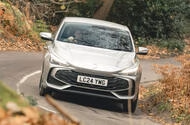What Went Wrong with the MG 3’s Safety in Recent Crash Tests?
If you’ve been eyeing the MG 3 as your next city car, you might want to hit pause for a moment. Europe’s top vehicle safety authority, Euro NCAP, recently uncovered a critical flaw in the MG 3’s driver’s seat during a standard crash test. The outcome? Let’s just say it’s not the kind of result any carmaker wants to see.
Why Did the Driver’s Seat Fail During the Crash Test?
During Euro NCAP’s frontal offset crash test—a scenario where 40% of the car’s front end smashes into a barrier—the MG 3’s seat latching mechanism gave way. Instead of holding firm, the driver’s seat twisted dramatically. This isn’t just a technical hiccup. When the seat shifted, the crash test dummy’s right leg took a much harder hit than it should have, earning the car a “poor” score for protecting the driver’s right femur.
To put this in perspective, Euro NCAP has been running these tests for nearly three decades and had never seen a seat fail like this. That’s a big deal. Aled Williams, Euro NCAP’s programme director, called it “an almost unheard-of occurrence,” highlighting just how rare and serious this problem is.
What Does This Mean for MG 3 Owners and Shoppers?
If you already own an MG 3 or are considering buying one, here’s the key detail: MG has responded quickly by reinforcing the seat latching mechanism, with updates rolled out from August onwards. But—and this is important—these fixes don’t apply to cars already delivered to customers since the model’s launch last year. So, if your MG 3 was built before the fix, it may still have the original, potentially faulty mechanism.
Euro NCAP has flagged these issues to the relevant authorities, who will decide if a recall is necessary. For now, MG Motor UK has been contacted for further comment, but there’s no official recall just yet.
Is the Airbag Also a Concern?
Unfortunately, the seat wasn’t the only thing under scrutiny. Euro NCAP found that in a crash, the driver’s head could “bottom out” through the airbag—meaning the airbag didn’t provide full protection. As a result, the MG 3 only scored an “adequate” rating for head protection.
MG has promised to tweak the airbag design, with changes expected in October. But, just like the seat fix, these improvements won’t be retrofitted to cars already on the road.
How Did This Affect the MG 3’s Safety Rating?
Here’s where things get a bit complicated. Despite these serious issues, the MG 3 still received a four-star rating out of five from Euro NCAP. Why? Because, until now, Euro NCAP’s scoring system didn’t specifically penalize cars for component failures like this. That’s about to change. The organization has announced it will update its protocols to ensure future ratings reflect any such failures.
What’s the Bigger Picture for Car Safety Standards?
This incident isn’t just about one model. It’s a wake-up call for the entire industry. Modern cars are packed with advanced safety features, but even a single weak link—like a seat latch—can undermine all that technology. Euro NCAP’s move to tighten its scoring system is a step toward making sure automakers can’t skate by on technicalities.
If you’re shopping for a new car, it’s a reminder to look beyond the star ratings. Dig into the details of crash test results, and don’t be afraid to ask tough questions at the dealership. After all, when it comes to safety, the fine print matters.
What Should You Do If You Own or Are Considering an MG 3?
If you already have an MG 3, check with your dealer to see if your car is affected by the seat or airbag issues. Stay tuned for updates from MG and the authorities—especially if a recall is announced. If you’re in the market for a new MG 3, make sure you’re getting a model built after the safety fixes were implemented.
At the end of the day, car safety isn’t just about passing tests—it’s about real-world peace of mind. The MG 3’s recent troubles are a reminder that even well-established brands can stumble, but also that robust testing and transparency are what keep drivers safe. Always do your homework, and don’t settle for less than the highest standards when it comes to your safety on the road.

